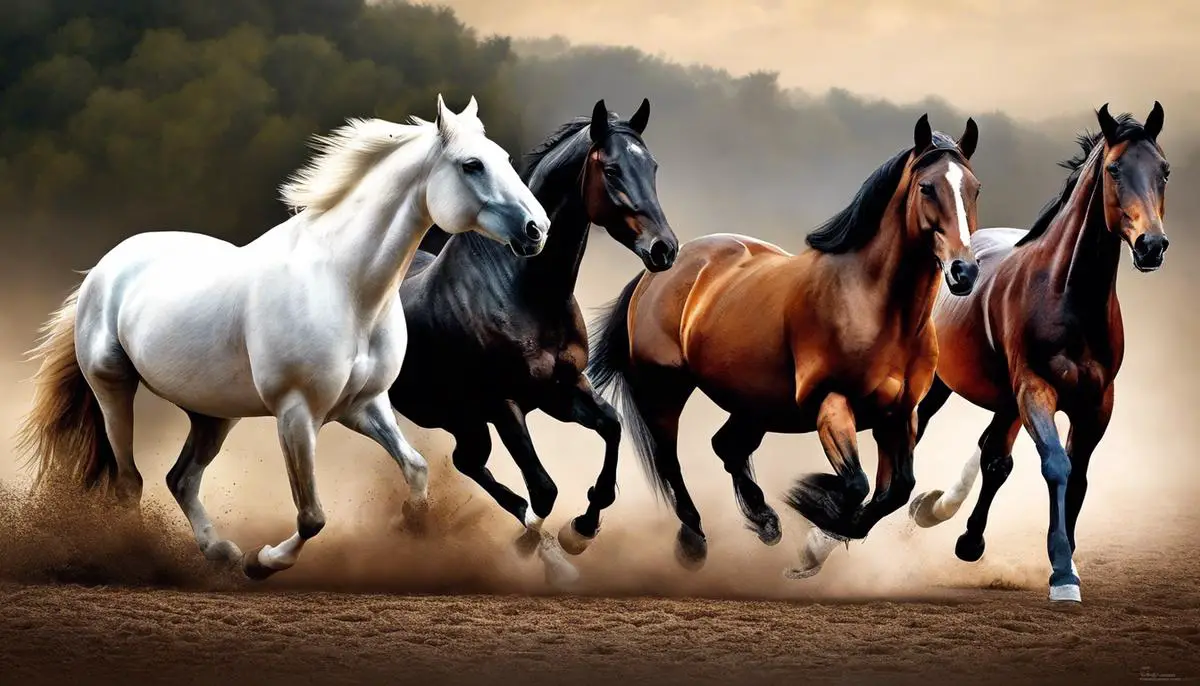Exploring the world of equines, one cannot help but be captivated by the distinctive characteristics and invaluable role of cold blooded horses. Traceable to the dawn of human civilization, these robust creatures, famed for their unflagging stamina and resilience, present a fascinating study for any equine enthusiast. This meticulous examination encompasses their intriguing moniker ‘cold blooded’, deciphers their unique physical and behavioral traits, and highlights their diverse breeds, all before culminating in an exploration of their significant contributions to our ecosystem.
Table of Contents (Horspedia)
Definition and Origin
The Intriguing Phenomenon of the “Cold Blooded Horse”: An In-depth Examination of its Historical Origin
A fascinating and somewhat less examined aspect of equine biology and history is the concept of the “Cold Blooded Horse.” Venturing into the realm of cold blooded horses, one might envisage a creature akin to a reptile, regulated by environmental temperature. However, this term does not designate a physiological condition but rather a specific type of horse breed – the draft horse.
The draft horse, colloquially dubbed the “cold-blooded” horse, distinguishes itself from its “warm-blooded” (thoroughbred and other sport horses) and “hot-blooded” (Arabian and other desert breeds) brethren in several remarkable ways. The term “cold-blooded,” in this context, serves to denote their calm and docile temperament, not their bodily temperature regulation.
Historically, the draft horse, or the cold-blooded horse, comes with a rich tapestry of stories spanning centuries. The horses’ ancestry can be traced back to the medieval era where they were bred for warfare – their considerable size and strength deemed crucial for carrying knights in heavy armor into battlefields.
As time flowed and the tides of war ebbed, these horses, resilient and adaptable as they are, found new roles in society. The Industrial Revolution saw draft horses pulling heavy loads, plowing fields, and contributing significantly to both transportation and agriculture. Evidence of this shift is abundant in historical records and vintage photographs depicting the monumental contribution of these magnificent beasts to human progress.
Examining their physical characteristics, an observer would notice their impressive stature and build – typically standing between 16-18 hands (approximately 64–72 inches) high and weighing from approximately 1500 to 2000 pounds. Breed specific attributes may vary slightly, but their muscular body and strong legs are unifying characteristics. Their powerful constitution dramatically contrasts their gentle disposition, which makes them favorable amongst enthusiasts and professionals alike.
Famous draft horse breeds include the Belgian, Clydesdale, Percheron, and Shire. Each breed carries distinct histories and characteristics, further highlighting the rich diversity within this group of equines. For instance, the Belgian Draft Horse, known for its incredible strength, hails from the Brabant region of modern Belgium. The Clydesdale, easily recognizable through popular culture icons like Budweiser’s famous team, traces its roots to Scotland.
Through times of war and industrial growth, the cold blooded horse has remained a constant in human civilization. Their historical importance, physical prowess, and docile temperament endow them with an irreplaceable role in the annals of equine history. Truly, the cold-blooded horse encapsulates a unique blend of strength and serenity, contributing to both their historical use and enduring popularity.
Understanding such intricacies of the equine world uncovers a fascinating facet of human history. Indeed, a closer look at the cold-blooded horse is not only a study of this remarkable animal but also a reflection upon our own, deeply intertwined history. These equine giants have witnessed and shaped the course of human history, and studying them illuminates the paths of both past and future travels.

Photo by ranjbarpic on Unsplash
Physical Traits
Understanding the Difference: The Physical Characteristics of Cold Blooded Horses
As we delve deeper into the nuances of the vast equestrian panorama, the physical distinctions that set cold blooded horses apart command our attention. Fundamentally, the term ‘cold-blooded horse’ pertains to a specific group of horse breeds that are predominantly large and sturdy. Characteristically, their corporeal attributes reflect their role in agriculture, transportation, and warfare, laying the basis for their niche in society.
Their discernible size, averaging between 16-19 hands high, is the most instantly recognizable trait of cold blooded horses. Renowned for their robustness, they encapsulate an imposingly muscular physique, accented by a broad chest – a testament to their ability to perform tough rides, pull heavy loads, and undeterred plodding in challenging terrains. Their legs, stout yet powerful, exude strength that belies their calm demeanor, while their hooves, markedly larger than their warm-blooded counterparts, offer them additional stability.
Adding to their easily distinguishable physique is their brawny neck, which leads gracefully into a large head marked by expressive, kindly eyes, and gentle mien. This distinctive feature does not merely add points to their aesthetic appeal but also plays a significant role in their working capabilities, providing the necessary balance while carrying heavy loads.
Their thick skin and dense double coat, an essential adaptive feature, facilitate temperature regulation amid extreme weather conditions, equipping these durable creatures for their historical roles in warfare and agriculture in various climates. Furthermore, the color palette of cold-blooded horses ranges widely, incorporating hues of black, brown, bay, gray, and chestnut – adding more richness to their already fascinating profiles.
Another significant physical characteristic of cold-blooded horses lies beneath their surface, in their metabolic processes. While not related to their biological thermoregulation, these horses possess slower metabolic rates than their “hot-blooded” counterparts, leading to less outbursts of energy but longer endurance. This mirrors their historical roles, which depended not on lightning-fast speeds, but rather consistent, steady workloads.
Examining these distinctive attributes of cold-blooded horses triggers a profound respect for their resilience and inherent strength. They remind us of the times when the pace of life was more in tune with nature, and workhorses were an integral part of human life. Rooting from their historical utility to their enduring presence today, cold blooded horses symbolize a humble embodiment of reliability and strength. As we continue to explore the depth of their uncanny blend of might and gentleness, their understanding remains essential to furthering equestrian knowledge.

Behavioral Characteristics
While we have thus far explored the fascinating physical attributes of cold blooded horses, their demeanor and behavioral traits are of equal importance and endearing interest. By discussing these aspects, we delve deeper into the captivating nature of these remarkable animals, enhancing our understanding of their value and significance.
Firstly, cold blooded horses are renowned for their calm and easygoing temperament. These characteristics are the cornerstone of their classification as “cold-blooded,” originating from older English parlance that referred to a person or animal displaying similar behavioral traits. Their gentle disposition makes them excellent companions for both novice and seasoned equestrians.
Typically, they exhibit a notable degree of patience, which underlines their versatility across various working conditions – from the plow to the carriage. Their patience comes with an innate strength to endure arduous tasks without agitation, thus manifesting their dependable nature.
Further, these horses are highly adaptable, reflecting their historical transition from the battlefield to industrial and agricultural settings. Their behavior mirrors their flexibility in handling changing scenarios with nonchalance — another testament to their “cold-blooded” demeanor.
Notably, despite their imposing physical attributes, cold blooded horses surprisingly express a high tolerance for other animals and people, including children. This cohabitation capacity underscores their benevolent nature that compounds their value beyond their physical contribution — a trait cherished by their caretakers.
Moreover, as creatures of habit, these horses typically uphold routines and show resistance to abrupt changes. This adherence to routine stems from the horse’s instinctual drive for consistency, contributing to their behavioral predictability.
While they are touted for their reserved demeanor, cold blooded horses also display a unique intelligence that has allowed them to be effective across diverse tasks throughout history. This intellectual aspect positions them as receptive learners, enabling them to be trained in performing intricate tasks.
However, one must not mistake their calmness for a lack of spirit. These horses, when well cared for, can exhibit vibrant personalities and establish deep bonds with their human companions, demonstrating the remarkable inter-species understanding and relationship.
In conclusion, the behavioral traits of cold blooded horses, combined with their physical traits, make them an exemplary exhibit of our equine companions. With their calm disposition, adaptability, tolerance, adherence to routine, and remarkable intelligence, they elegantly represent the enduring horse-human relationship that has shaped our shared history. Their qualities thus warrant serious appreciation and study in the rich tapestry of equestrian knowledge. Their inability to communicate verbally only accentuates the profundity of their silent messages, speaking volumes about their significance, nature, and sheer beauty.

Breeds and Types
The term “cold-blooded” when referring to horses doesn’t necessarily correspond to any factual temperature contrast from other horse breeds. As per the equestrian categorizations, the cold-blooded horses, or draft horses, deviate from the “warm-blooded” or “hot-blooded” horses based on their temperament alone, not their physiological temperature regulation.
Technically, there isn’t a specific breed that is exclusive to the “cold-blooded” classification. Instead, the group represents an array of horse breeds recognized for their particular temperament and exceptional traits that set them apart. There are, however, some breeds that significantly exemplify these traits more vividly, and thus are often the poster representation of this group.
The Belgian Draft Horse, one of the most ancient draft horse breeds, exhibits the typical cold-blooded horse traits, including substantial size complemented by a good-natured disposition. With a strong muscular physique and the ability to pull an immense weight, these horses display the classic sturdy features inherent to cold-blooded horses.
The breed known as Clydesdales often weights around 2000 pounds and stands tall, between 16 to 18 hands. They are the gentle giants of the horse world, expertly balanced between strength and grace. Their reputation as the breed used by breweries for beer delivery is a testament to their power and work ethic.
The Shire Horse, native to the British Isles, is another notable cold-blooded breed. Most distinctive for their immense size, they stand as some of the most sizable horses in the world. Despite their intimidating size, they are famous for their calm demeanor.
The Percheron breed hails from France and were originally bred as warhorses. These horses are traditionally smaller than the Shire or Clydesdale; nonetheless, they maintain the strength typical of a draft breed. Their athleticism and versatility have enabled them to adapt to various roles, from farming to carriage driving, and even riding.
With height ranging from 16 to 18 hands and an average weight of 1400 to 1700 pounds, the Dutch Draft Horse is the most muscular draft breed. Although comparatively smaller in size than some of its relatives in the breed, this horse is renowned for its strength and endurance.
Lastly, even without the deep-set chest, the Fjord Horse of Norway exhibits the typical cold-blooded horse traits of strength, endurance, and a mild mannered temperament. With its unique two colored mane and coat colors ranging from grey to brown to a rare white, this breed represents an ancient lineage that were utilized by Vikings.
In concluding this dive into the realm of cold-blooded horses, we have seen that they are especially suited to physically demanding roles due to their strength and endurance. Their ability to pull heavy loads, coupled with a calm, adaptable temperament, have made them invaluable in both historical and modern contexts. Whether serving on the fields of battle, the agricultural landscape or the bustling city streets, these breeds have earned their classification as “cold-blooded” through their serene demeanor and ardor for vigorous work. Their tenacity, strength, and serene disposition underline the fascinating complexity of equine breeds and capture the heart of humankind’s historical and ongoing connection with these remarkable creatures.

The Role and Uses of Cold Blooded Horses
The versatility of cold-blooded horses is evidenced in the myriad of roles they play in modern society. As times have evolved and technological advancements have superseded their traditional roles, they remain valued for their ardor and tenacity, which are aptly deployed in various notable sectors today.
One particularly indispensable role of cold-blooded horses is in the world of forestry. Due to the ecosystem-sensitive nature of this work, which often demands the careful extraction of timber from densely wooded areas to avoid damage to the terrain, the use of machinery is often detrimental. Here, the prowess of cold-blooded horses comes to the fore. Their muscular build, coupled with their natural tendency for steady, coordinated movement, makes them perfectly fitted for this task.
Further extending their contribution to the forestry industry, cold-blooded horses play an instrumental role in recreational logging competitions. These events test the skills of both horse and handler in negotiating logs through obstacle courses, with cold-blooded breeds such as the Belgian Draft, the Shire, and the Clydesdale proving particularly apt in these challenges.
In recognition of their impressive physical traits, some cold-blooded horses have found a niche in show competitions. In these events, the horses pull heavy weights to demonstrate their strength. Clydesdales and Belgians, among other cold-blooded breeds, regularly feature in these events, presenting a captivating spectacle that offers a revitalized respect for these gentle giants.
In the realm of leisure and recreation, cold-blooded horses are favored for trail riding, particularly for novice riders or those desiring an easy-going and cooperative steed, given their calm demeanor and patience. Their sturdy physique and unflappable disposition also make them the first choice for therapeutic riding programs, where the rhythmic movement of the horse can provide physical and emotional therapy for individuals with disabilities.
Not to be limited to just physical roles, cold-blooded horses engage in cognitively challenging tasks as well. A common sight in Hollywood and other film production hubs, these equines often assume roles in films, commercials, and live performances due to their trainable nature and striking appearance.
In essence, cold-blooded horses continue to serve society in multifaceted ways, showcasing their physical prowess and amenable nature. Far from antiquated, they play integral roles in industries from forestry to entertainment, offering compelling evidence of their enduring relevance and versatility. Indeed, a stronger appreciation of these impressive animals offers insights into their varied capabilities and contributions, further anchoring their place within modern society. The heart, mind, and soul of the cold-blooded horse, united with their unique physical attributes, play a crucial role in molding the narrative of their continued utilitarian value.

Our journey ends with an elaborate understanding of this remarkable equine group. Through every stride and sweat, cold blooded horses have embedded their footprints in the soil of time, signifying their ceaseless contribution to humankind. The durable, steady, and empathetic friend to humankind, these cold blooded breeds remain indispensable to our social fabric. As we gallop forward, these breeds, with their diverse types and ever-questioning roles, invite us to continue exploring the vast and mysterious pastures of the equine species.

